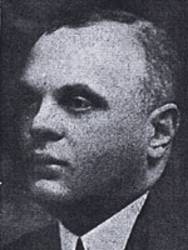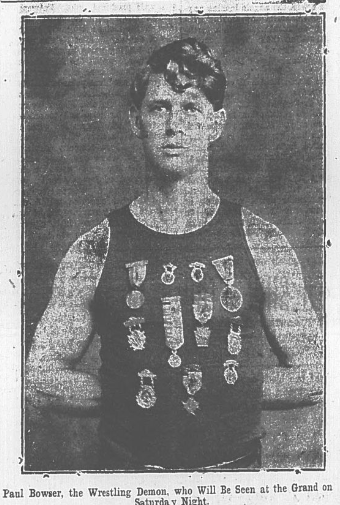Продвижение борьбы
Профессиональная борьба превратилась в спортивное зрелище из законных соревнований по двум причинам.. Я много писал о первой причине.. Законные поединки между борцами одинакового уровня зачастую были долгими., скучные дела с небольшим действием. Эти соревнования отпугнули болельщиков и не позволили профессиональному рестлингу стать зрелищным видом спорта..
О второй причине я не так много написал. Появление влиятельных промоутеров в крупных городах или районах Соединенных Штатов в конце 1910 -х и начале 1920 -х годов. Как только политические подключенные владельцы бизнеса взяли на себя спорт, Владельцы бизнеса хотели контролировать все аспекты спорта, включая борцов, который несет чемпионат мира.

Фотография Джека Керли из 1910 (Всеобщее достояние)
В течение первых двух десятилетий спорта, Местные спортивные мужчины часто служили промоутерами, обеспечивая место для матча, которое они хотели увидеть. Эти покровители часто принимали ванну на мероприятии, потому что толпы пронумеровались сотнями. Зрители не принесли достаточного дохода, чтобы заплатить борцам или покрыть арендную плату за место проведения.
Эдвин Бибби против. Джо Актон Матч в 1882 является примером этой рекламной договоренности. Местные нью -йоркские спортивные мужчины вкладывают деньги, чтобы арендовать Мэдисон Сквер Гарден. Бибби защищал американский чемпионат по борьбе в супертяжелом весе перед тремя сотнями зрителей. Платная толпа не приблизилась к оплате за место, гораздо меньше $350 Кошелек победителя. Сторонники понесли большие финансовые потери.
Между 1890 и 1910 -е годы, Менеджер борцов также служил квази-промотором в выстраивании в выравнивающие покровители и места для больших матчей. В 1910, Менеджер Фрэнка Гота, Эмиль Саунд, Аранжируется с Чикагским «Эмпайр -клубом для клуба», чтобы обеспечить место для защиты титула Готча со Станислаусом Збишко.
Gotch потребовал шестьдесят процентов квитанций ворот. The Empire Club занял тридцать пять процентов, покидая Збишко, только пять процентов ворот.
In the early 1910s, Местные бизнесмены начали открывать рекламные акции в крупных городах и городах. Джерри М.. Стены могут быть первым обычным промоутером города. Он управлял Эдом «Стронглером» Льюисом во время Льюиса в Кентукки. Стены дали Льюису его имя, как Льюис ранее боролся под его настоящим именем, Роберт Фридрих, или Фредрик.

Фото Пола Баузера как борца в 1914. Он продвигал профессиональную борьбу в Бостоне в течение нескольких десятилетий. (Всеобщее достояние)
Стены продвигали Лексингтон, Kentucky, его родной город и Луисвилл, Kentucky, between 1913 и 1915. Льюис регулярно намекал на эти карты.
Когда Льюис уехал в Нью -Йорк с новым менеджером, Билли Сандоу, Стены перестали продвигать как борьбу, так и бокс. Я не могу найти никаких ссылок на него после 1915.
Джек Керли заставил себя первым промоутером большого города, Когда Керли открыл свое повышение в Нью -Йорке во время 1915. Керли сотрудничал с Сэмом Ракманом на осенней версии Рахмана 1915 New York International Wrestling Tournament.
Первоначально, Керли продвигал бокс и борьбу. Текс Рикард сжимал Керли из бокса, Итак, Керли сосредоточился на профессиональной борьбе. Использование его политических связей и контроль над самым большим потенциальным рынком в стране, Керли вскоре контролировал чемпионат мира.
By the early 1920s, Пол Баузер установил свое повышение в Бостоне. Том упаковывает контролируемый ST. Луис. Другие региональные промоутеры открыли рекламные акции в крупных и средних городах по всей территории Соединенных Штатов и Канады. Эти промоутеры хотели контролировать все в профессиональной борьбе, Таким образом, они фактически закончили законные конкурсы. Единственные законные конкурсы после появления местных рекламных акций были двойные пересечения или согласованные конкурсы для урегулирования рекламных различий. Законная профессиональная борьба закончилась в Америке.
You can leave a comment or ask a question about this or any post on my Facebook страницы.
Sources: The New York Times, Август 8, 1882, р. 2, Стар Трибьюн (Миннеаполис, Миннесота), Февраль 15, 1910, р. 10 и Lexington Herald, Июль 1, 1913, р. 9

